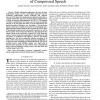Free Online Productivity Tools
i2Speak
i2Symbol
i2OCR
iTex2Img
iWeb2Print
iWeb2Shot
i2Type
iPdf2Split
iPdf2Merge
i2Bopomofo
i2Arabic
i2Style
i2Image
i2PDF
iLatex2Rtf
Sci2ools
TASLP
2002
2002
Perception-based partial encryption of compressed speech
Mobile multimedia applications, the focus of many forthcoming wireless services, increasingly demand low-power techniques implementing content protection and customer privacy. In this paper low complexity perception-based partial encryption schemes for speech are presented. Speech compressed by a widely-used speech coding algorithm, the ITU-T G.729 standard at 8 kb/s, is partitioned in two classes, one, the most perceptually relevant, to be encrypted, the other, to be left unprotected. Two partial-encryption techniques are developed, a low-protection scheme, aimed at preventing most kinds of eavesdropping and a high-protection scheme, based on the encryption of a larger share of perceptually important bits and meant to perform as well as full encryption of the compressed bitstream. The high-protection scheme, based on the encryption of about 45% of the bitstream, achieves content protection comparable to that obtained by full encryption, as verified by both objective measures and forma...
| Added | 23 Dec 2010 |
| Updated | 23 Dec 2010 |
| Type | Journal |
| Year | 2002 |
| Where | TASLP |
| Authors | Antonio Servetti, Juan Carlos De Martin |
Comments (0)

